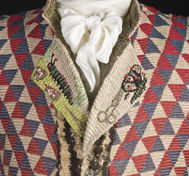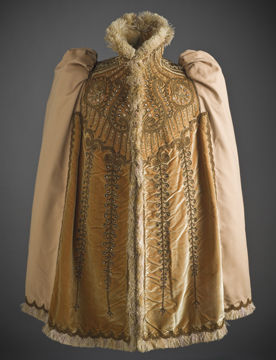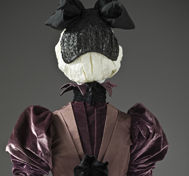"Fashioning Fashion: European Dress in Detail, 1700-1915" @ The Los Angeles County Museum of Art (LACMA)
Image: Photo © 2010 Museum Associates/LACMA
LOS ANGELES, CA.- The Los Angeles County Museum of Art (LACMA) presents Fashioning Fashion: European Dress in Detail, 1700-1915 celebrates the museum's groundbreaking acquisition of a major collection of European men's, women's, and children's garments and accessories.The exhibition tells the story of fashion's aesthetic and technical development from the Age of Enlightenment to World War I. It examines sweeping changes in fashionable dress spanning a period of over two hundred years, and evolutions in luxurious textiles, exacting tailoring techniques, and lush trimmings.
Highlights include an eighteenth-century man's vest intricately embroidered with powerful symbolic messages relevant to the French Revolution; an evening mantle with silk embroidery, glass beads, and ostrich feathers designed by French couturier Émile Pingat (active 1860-96); and spectacular three-piece suits and gowns worn at the royal courts of Europe.
The exhibition is curated by Sharon S. Takeda, Senior Curator and department head, and Kaye D. Spilker, Curator, LACMA's Costume and Textiles department.
This exhibition was organized by the Los Angeles County Museum of Art. The acquisition was made possible by Atelier, LACMA's acquisitions committee for Costumes and Textiles. Atelier raises critical funds to support acquisitions for LACMA’s Costume and Textiles Department, allowing the museum to take advantage of opportunities when rare collections or special objects become available.
Man's Suit. France, c. 1760. (M.2007.211.946a-c). Photo © 2010 Museum Associates/LACMA
Coat and waistcoat: wool plain weave, full finish, with sequins and metallic-thread embroidery; Breeches: wool plain weave, full finish, with silk and metallic-thread passementerie.
Purchased with funds provided by Suzanne A. Saperstein and Michael and Ellen Michelson, with additional funding from the Costume Council, the Edgerton Foundation, Gail and Gerald Oppenheimer, Maureen H. Shapiro, Grace Tsao, and Lenore and Richard Wayne.
Vest. France. 1789-94..(M.2007.211.1078). Photo © 2010 Museum Associates/LACMA
Linen canvas with silk needlepoint, linen plain weave with silk supplementary warp cut-pile trim and silk embroidery. Cb. 26 1/2 in. (67.3 cm)
Purchased with funds provided by Suzanne A. Saperstein and Michael and Ellen Michelson, with additional funding from the Costume Council, the Edgerton Foundation, Gail and Gerald Oppenheimer, Maureen H. Shapiro, Grace Tsao, and Lenore and Richard Wayne.
Mantle. Paris, c. 1891. (M.2007.211.38). Photo © 2010 Museum Associates/LACMA
Wool plain weave and silk velvet with silk and metallic-thread embroidery, glass beads, and ostrich-feather trim. Cb. 35 3/4 in. (90.8 cm)
Purchased with funds provided by Suzanne A. Saperstein and Michael and Ellen Michelson, with additional funding from the Costume Council, the Edgerton Foundation, Gail and Gerald Oppenheimer, Maureen H. Shapiro, Grace Tsao, and Lenore and Richard Wayne.
Woman's Dress. House of Rouff, circa 1897. (M.2007.211.37a-b). Photo © 2010 Museum Associates/LACMA
Silk twill and silk cut velvet on twill foundation.
Purchased with funds provided by Suzanne A. Saperstein and Michael and Ellen Michelson, with additional funding from the Costume Council, the Edgerton Foundation, Gail and Gerald Oppenheimer, Maureen H. Shapiro, Grace Tsao, and Lenore and Richard Wayne.

/https%3A%2F%2Fprofilepics.canalblog.com%2Fprofilepics%2F1%2F0%2F100183.jpg)
/https%3A%2F%2Fstorage.canalblog.com%2F03%2F02%2F119589%2F96711876_o.jpg)
/https%3A%2F%2Fstorage.canalblog.com%2F11%2F31%2F119589%2F94773502_o.jpg)
/https%3A%2F%2Fstorage.canalblog.com%2F20%2F83%2F119589%2F94772815_o.jpg)
/https%3A%2F%2Fstorage.canalblog.com%2F26%2F72%2F119589%2F75604929_o.jpg)
/https%3A%2F%2Fstorage.canalblog.com%2F59%2F60%2F119589%2F26458628_o.jpg)










/http%3A%2F%2Fstorage.canalblog.com%2F72%2F31%2F119589%2F34999482_o.jpg)
/http%3A%2F%2Fstorage.canalblog.com%2F75%2F39%2F119589%2F34625500_o.jpg)
/http%3A%2F%2Fstorage.canalblog.com%2F45%2F28%2F119589%2F34064704_o.jpg)
/http%3A%2F%2Fstorage.canalblog.com%2F46%2F33%2F119589%2F34057075_o.jpg)